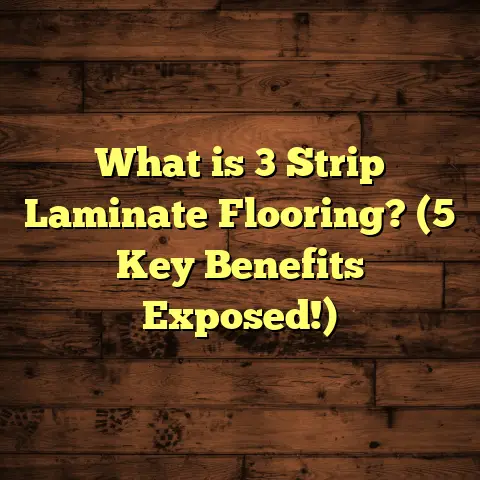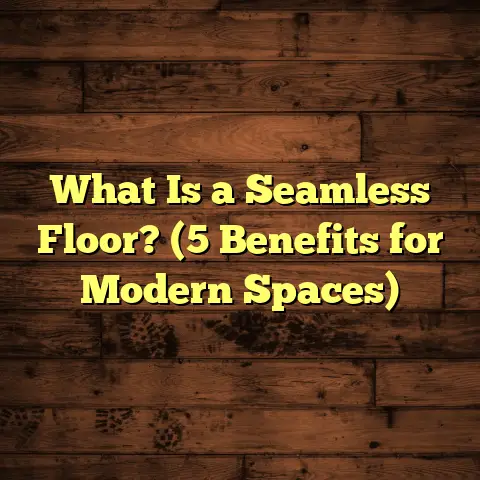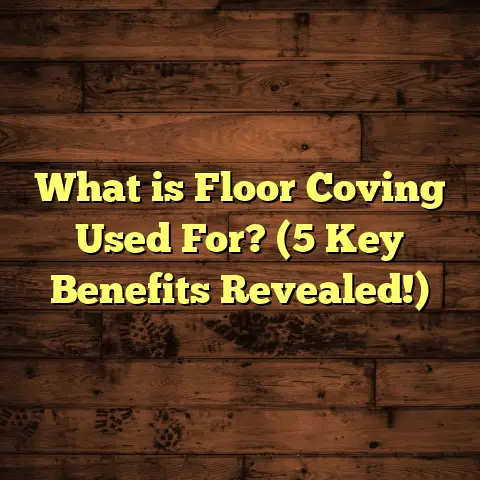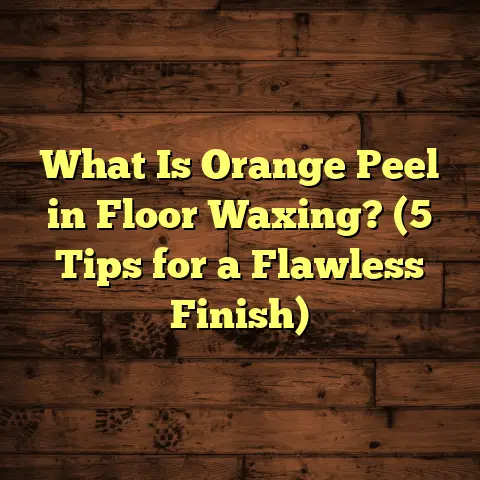What is Floor Coverings? (5 Essential Types You Need to Know)
Did you know that the global flooring market is projected to surpass $450 billion by 2028? This huge number reflects how much importance people place on their floors—not just as a surface to walk on but as a key part of their living or working environment. I’ve spent years working as a flooring contractor, and I can tell you that picking the right floor covering is more complex than most folks imagine. It’s about finding the perfect balance between style, durability, comfort, and budget.
If you’ve ever wondered what exactly floor coverings are, or felt overwhelmed by the many options available today, you’re not alone. I’ve helped countless homeowners and businesses navigate this maze, sharing what I’ve learned from hands-on experience and research. So, let’s take a detailed look at what floor coverings really are, why they matter, and explore five essential types that you should know about before making your next flooring decision.
What Is Floor Covering?
Floor covering refers to any material applied on top of a structural floor to create a finished surface that’s walkable, functional, and visually appealing. This layer protects the subfloor beneath and can add comfort, insulation, sound absorption, and even improve indoor air quality. Floor coverings come in a wide range of materials, textures, colors, and installation methods.
When someone says “flooring,” they generally mean the finished surface you see in a room—whether that’s hardwood planks, tiles, carpet, or vinyl sheets. The choice depends on factors like where it will be installed (living room vs. bathroom), how much traffic the area gets, your budget, and personal taste.
From my experience, many people don’t initially realize how much their floor covering choice affects not only the aesthetics but also the long-term maintenance costs and durability of their space. For example, choosing carpet in a high-traffic kitchen might lead to frustration with stains and wear, while tile or vinyl would stand up better.
Floor coverings have been around for centuries—historically using materials like stone slabs or woven fibers—but today’s market offers far more advanced options engineered for specific needs. Understanding the basics will help you avoid costly mistakes and pick the right solution that fits your lifestyle.
Why Floor Coverings Matter
You might ask: Why not just leave concrete or wood subfloors exposed? Well, while some modern designs do embrace exposed concrete or polished concrete floors, most traditional buildings use floor coverings for several reasons:
- Comfort: Bare concrete or wood can be hard and cold underfoot.
- Safety: Some floor coverings provide slip resistance.
- Aesthetics: Flooring sets the tone for a room’s style.
- Durability: Protects the structural floor from damage.
- Acoustics: Carpets and some vinyl reduce noise.
- Insulation: Some floor coverings help keep rooms warmer.
In my early days as a contractor, I worked on an office renovation where the client opted for polished concrete floors. It looked sleek but was quite cold and uncomfortable for staff who stood for long periods. We later added area rugs in key spots to improve comfort. That taught me firsthand how flooring choices impact daily life.
The 5 Essential Types of Floor Coverings You Need to Know
Now let’s dig into five major types of floor coverings that dominate residential and commercial projects alike. I’ll share pros and cons, real-world examples from my work, relevant data points, and tips to help you decide which might be best for your situation.
1. Hardwood Flooring: Classic Beauty and Longevity
Hardwood flooring is made from solid wood planks milled from hardwood trees like oak, maple, cherry, or walnut. It has been a favorite choice for centuries due to its natural beauty and durability.
Key Advantages of Hardwood
- Timeless Appeal: No other flooring looks quite like real wood. Its grain patterns are unique to each plank.
- Longevity: Hardwood floors can last 50 years or more with proper care.
- Value: Homes with hardwood floors often sell faster and for higher prices. Studies show hardwood flooring can increase home resale value by 2-5%.
- Refinishing: When scratched or worn, hardwood can be sanded and refinished multiple times.
Challenges
- Cost: Hardwood tends to be one of the more expensive flooring options.
- Moisture Sensitivity: Wood expands and contracts with humidity changes; it’s not ideal for bathrooms or basements.
- Maintenance: Requires regular cleaning and occasional refinishing.
My Hardwood Stories
I recall installing hardwood floors in a 1920s craftsman-style home. The owners wanted to keep the character intact while upgrading durability. We chose red oak finished with a matte polyurethane coat to retain a natural look but add protection. Over the years, they sent photos showing how the floor aged beautifully with their family’s life—scratches turned into stories.
In another project, we replaced worn-out parquet flooring with engineered hardwood (more on this later) to maintain the wood look while improving moisture resistance in the kitchen.
Hardwood Market Facts
According to the National Wood Flooring Association (NWFA), over 80% of homeowners prefer hardwood floors when choosing flooring upgrades. The association reports that refinishing hardwood floors costs about $3-$5 per square foot on average—a cost many consider worthwhile given the extended lifespan.
2. Laminate Flooring: Affordable Style with Durability
Laminate flooring consists of multiple layers fused together. At its core is fiberboard topped by a photographic image layer that mimics wood, stone, or tile — covered by a durable wear layer.
Why Laminate Works for Many
- Budget-Friendly: Typically 30-50% less expensive than hardwood.
- Scratch Resistance: The tough top layer resists scratches better than real wood.
- Installation: Most laminate floors use click-lock systems allowing DIY installation.
- Variety: Wide range of styles imitate expensive surfaces at lower cost.
Drawbacks
- Moisture Sensitivity: Standard laminate swells if water penetrates seams.
- Less Refinishing Options: Once damaged beyond repair, it must be replaced.
- Feel: Can feel hollow or less natural underfoot compared to wood.
Stories From My Experience
I installed laminate for a young couple who loved the look of dark walnut but had pets and kids prone to spills and scratches. Laminate gave them the wood look they wanted without worrying about damage every day. They reported the floors held up well for over five years before showing signs of wear.
In rental properties I’ve handled, laminate is a favorite because it balances looks with easy replacement when tenants move out.
Market Trends
Laminate flooring sales have seen steady growth globally due to affordability and technological improvements in wear layers. In North America alone, laminate accounts for about 10-15% of residential flooring sales.
3. Vinyl Flooring: Waterproof Versatility
Vinyl flooring has evolved tremendously from its linoleum roots. Today’s luxury vinyl tile (LVT) or plank (LVP) products mimic wood and stone convincingly while offering waterproof resilience.
What Makes Vinyl Popular?
- Waterproof: Excellent choice for kitchens, bathrooms, basements.
- Comfort: Softer underfoot than tile or wood; quieter too.
- Low Maintenance: Easy to clean with just sweeping and mopping.
- Installation Options: Glue-down, click-lock floating floors are available.
Some Downsides
- Durability Limits: While tough, vinyl can dent or tear under heavy furniture.
- Appearance: Though realistic, some purists prefer natural materials.
- Environmental Concerns: Vinyl is petroleum-based; recycling options are limited.
My Vinyl Flooring Projects
One memorable project was a full basement makeover where waterproofing was critical due to occasional seepage. We installed luxury vinyl plank flooring throughout. The clients loved how warm it felt compared to tile or concrete plus it was easy to clean after kids’ messy activities.
Commercial clients appreciate vinyl too—like boutique shops where stylish appearance plus durability are needed without high cost.
Industry Data
The global vinyl flooring market is expected to grow at around 6% annually through 2027 due to demand in both residential upgrades and commercial renovations. Vinyl now accounts for roughly 25% of all new flooring installations in North America.
4. Tile Flooring: Durability Meets Design Flexibility
Tile flooring covers ceramic, porcelain, and natural stone tiles laid in various patterns and finishes. It’s known for durability and water resistance.
Tile Strengths
- Water Resistance: Ideal for wet areas like showers and kitchens.
- Durability: Tiles resist scratches and stains better than most other surfaces.
- Design Options: Countless colors, shapes, sizes—from subway tile to intricate mosaics.
Considerations
- Cold & Hard: Tile can feel cold underfoot; area rugs or radiant heating help.
- Installation Cost: Professional installation tends to be labor-intensive.
- Grout Maintenance: Grout lines may stain or require sealing periodically.
Personal Tile Experiences
I once installed large-format porcelain tiles in a restaurant kitchen that faced heavy foot traffic and spilled liquids daily. The tiles held up brilliantly without chipping or discoloration after years of use.
In residential homes, I often recommend tile for bathrooms or mudrooms because it handles moisture better than wood or carpet.
Technical Data
Porcelain tile typically has a density of around 2.4 g/cm³ compared to ceramic’s 1.8 g/cm³; this makes porcelain more water-resistant and harder-wearing. The Porcelain Enamel Institute rates tiles by PEI scale—higher ratings mean more durability under foot traffic.
5. Carpet Flooring: Warmth and Comfort Underfoot
Carpet remains a popular choice where softness matters most—think bedrooms, living rooms, and cozy offices.
Benefits of Carpet
- Comfortable: Cushions feet and reduces fatigue when standing long.
- Sound Absorption: Carpet absorbs noise better than hard surfaces.
- Variety & Style: Available in endless colors and textures—plush, Berber, wool blends.
Issues To Keep in Mind
- Maintenance: Needs regular vacuuming; spills require quick cleaning.
- Allergens: Can trap dust mites and allergens if not cleaned often.
- Durability: Lower quality carpets may mat down quickly in high traffic areas.
My Carpet Stories
A family I worked with loved carpet for their kids’ playroom because it provided cushioning during tumbles. They chose stain-resistant nylon carpet with an 8-lb pad underneath for extra softness.
Carpet still holds roughly 30% market share in U.S. residential flooring despite competition from harder surfaces—a testament to its enduring appeal where comfort counts.
How To Choose The Right Floor Covering For You?
You might wonder: With all these options available, how do I pick the right one? I often get asked this question by customers who want durable floors but also care about style and budget.
Here’s a simple approach based on what I’ve learned:
| Factor | Consideration | Suggested Flooring Types |
|---|---|---|
| Room Usage | High moisture? High traffic? Comfort needs? | Vinyl/tile for wet; hardwood/laminate for living areas; carpet for bedrooms |
| Budget | How much can you spend upfront & on maintenance? | Laminate/vinyl for tight budgets; hardwood/tile for investment |
| Maintenance Willingness | How much time will you spend cleaning & upkeep? | Carpet & hardwood require regular care; vinyl & tile are low maintenance |
| Installation Flexibility | DIY vs professional help | Laminate/vinyl often DIY-friendly; tile & hardwood usually pro-installed |
| Aesthetic Preference | Traditional warmth vs modern sleek look | Hardwood/carpet for warmth; tile/vinyl/laminate for various styles |
Real-Life Case Study: Balancing Looks & Functionality
Let me share one client story that sums up these considerations well:
The Smith family wanted new floors throughout their home but had a $15k budget. They needed durable floors safe for two toddlers plus pets—easy cleanup was a must. Their kitchen flooded occasionally due to plumbing issues.
We proposed:
- Engineered hardwood in living/dining rooms for warmth.
- Waterproof luxury vinyl plank in kitchen/bathrooms.
- Carpet in kids’ bedrooms for comfort with stain-resistant fibers.
This mix met their budget while addressing practical needs without sacrificing style. The Smiths were thrilled with how their floors looked after installation—and how easy they were to maintain afterward.
Maintenance Tips For Each Floor Covering Type
Knowing what type suits your needs is just half the battle—you also have to care for it properly:
| Flooring Type | Key Maintenance Tips |
|---|---|
| Hardwood | Sweep regularly; use damp mop; refinish every 7–10 years |
| Laminate | Clean spills quickly; avoid excess water; use manufacturer cleaners |
| Vinyl | Sweep/mop regularly; avoid abrasive cleaners |
| Tile | Clean grout lines; seal grout annually |
| Carpet | Vacuum frequently; deep clean yearly; spot clean spills ASAP |
Budget Considerations & Cost Breakdown
Flooring costs vary widely depending on material quality, installation complexity, region, and additional materials like underlayment or adhesives.
Here’s an average cost per square foot (materials + installation):
| Flooring Type | Cost Range (USD/Sq Ft) |
|---|---|
| Hardwood | $8 – $15 |
| Laminate | $2 – $7 |
| Vinyl | $3 – $8 |
| Tile | $5 – $15 |
| Carpet | $3 – $7 |
I always advise my clients to factor in waste allowance (usually 5–10%) plus potential subfloor repairs when budgeting.
Using Tools Like FloorTally For Accurate Estimates
One tool I recommend to homeowners and contractors alike is FloorTally—a platform that calculates flooring costs based on local material prices, labor rates, and waste factors.
It lets you customize selections across different materials, compare estimates, and visualize total project costs, saving hours hunting down quotes from multiple suppliers or installers.
For example, a client recently used FloorTally before ordering luxury vinyl plank flooring, which helped them plan the budget precisely, avoiding surprises at checkout.
Final Thoughts From Years On The Job
Choosing floor covering isn’t just picking something nice to look at—it impacts your daily life, home value, and even health.
I’ve walked thousands of rooms, worked on historic restorations, and helped families balance style with durability, and each project taught me something new about how floors shape our spaces.
So whether you lean toward classic hardwood, budget-friendly laminate, versatile vinyl, durable tile, or cozy carpet, remember that understanding pros, cons, and care needs will make your choice easier—and more satisfying over time.
Got questions about your specific project? Feel free to ask—I’m here to share everything I’ve picked up through years of hands-on experience!





